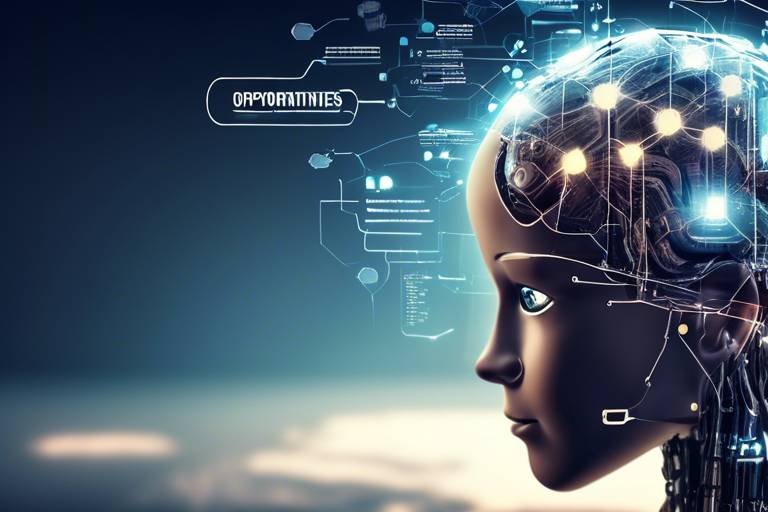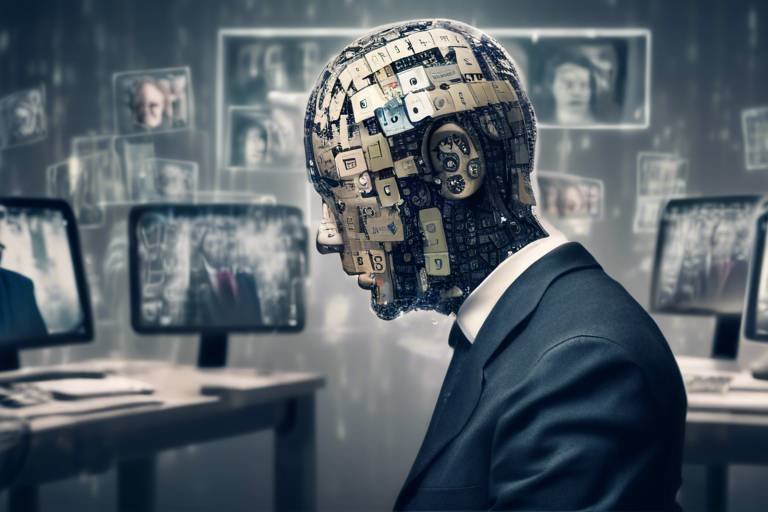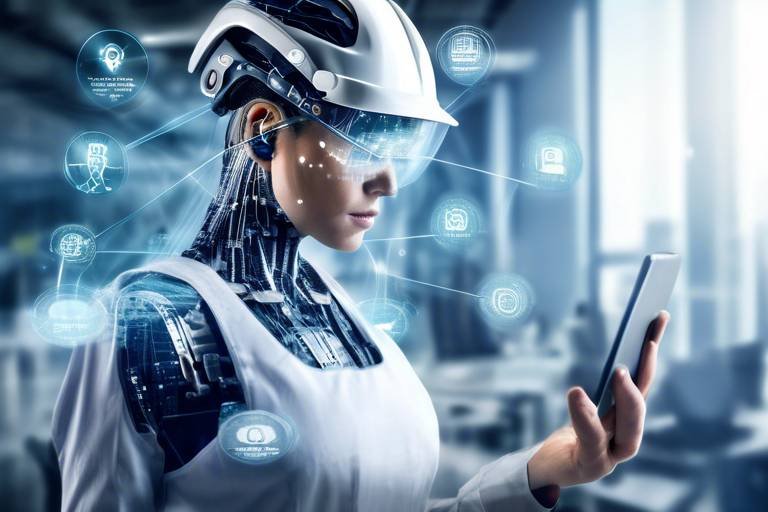Future of AI in Online Learning: Opportunities and Challenges
As we stand on the brink of a technological revolution, the integration of artificial intelligence (AI) into online learning is not just a trend—it's a transformative shift that promises to reshape education as we know it. Imagine a classroom where each student's learning experience is as unique as their fingerprint. That's the potential of AI in education! This article explores the myriad opportunities AI presents, from personalized learning experiences to enhanced engagement, while also addressing the challenges that educators and learners may face in this rapidly evolving landscape.
One of the most exciting advancements AI brings to the table is the ability to create personalized learning experiences. Picture this: a student struggling with math concepts is met with tailored exercises that adapt to their individual learning style and pace. AI algorithms analyze performance data and adjust the curriculum accordingly, ensuring that each learner receives the support they need to thrive. This approach not only enhances student engagement but also leads to improved outcomes, as learners feel more connected and invested in their education.
Automated assessment tools are revolutionizing the way we evaluate student performance. Gone are the days of tedious grading and delayed feedback! With AI, assessments can be conducted in real-time, providing immediate insights into a student's understanding of the material. However, while the benefits are clear, there are limitations to consider, such as the potential for bias in AI algorithms and the need for privacy protections. It's essential to navigate these waters carefully to ensure fair and equitable assessments for all students.
Imagine taking a quiz and receiving instant feedback on your answers. That's the power of AI-driven feedback mechanisms! These tools can significantly improve learning efficiency by allowing students to identify areas of weakness immediately. Research shows that timely responses can enhance understanding and retention, making learning a more dynamic and interactive process. However, it's crucial to implement these systems thoughtfully to avoid overwhelming students with information.
Adaptive testing is another groundbreaking application of AI in education. This innovative approach adjusts the difficulty of questions based on a student's responses, creating a personalized assessment experience. For instance, if a student excels in a particular topic, the system will present more challenging questions, while struggling students will receive simpler queries to help them build confidence. This method not only provides a more accurate measure of knowledge but also keeps students engaged by challenging them at just the right level.
Despite the numerous advantages, AI assessments are not without challenges. Issues like bias in AI algorithms can lead to unfair evaluations, while privacy concerns regarding student data must be addressed. It's vital for educators and institutions to engage in ongoing discussions about the ethical implications of using AI in assessments to ensure a fair and just educational environment.
AI's ability to analyze vast amounts of data is a game-changer for educators. By leveraging data analytics, teachers can gain actionable insights into student performance, identifying trends and areas for improvement. This information can inform teaching strategies and curriculum development, ultimately leading to a more effective learning experience. Imagine a world where educators can tailor their lessons based on real-time data—this is the future of teaching!
AI technologies, such as chatbots and virtual tutors, are making waves in the realm of student engagement. These tools foster greater interaction, making learning more enjoyable and accessible. For example, a chatbot can provide instant answers to student queries, creating a supportive learning environment. The more engaged students are, the more likely they are to succeed, and AI is playing a crucial role in this transformation.
Integrating AI with gamification strategies can significantly enhance motivation and participation among students. Think of it as turning learning into a game where students earn points and rewards for completing tasks. This approach taps into the natural human desire for achievement and competition, making education not just informative but also fun! Studies have shown that game-based learning can lead to higher retention rates and improved academic performance.
AI can also facilitate collaboration among students through intelligent grouping and communication tools. By analyzing students' strengths and weaknesses, AI can create groups that enhance learning experiences and foster social interaction. In virtual learning settings, where face-to-face interaction is limited, AI helps bridge the gap, ensuring that students feel connected and supported.
While AI holds immense potential to improve education, it also raises concerns about equity and accessibility. It's crucial to ensure that all learners have access to AI technologies and resources. By addressing these issues, we can create a more inclusive online learning environment that benefits everyone.
AI translation tools are breaking down language barriers, enabling non-native speakers to access educational content more easily. These tools enhance learning opportunities for diverse populations, ensuring that language is not a barrier to education. Imagine a classroom where every student, regardless of their language background, can participate fully—this is the promise of AI in education.
Ensuring equitable access to AI technologies is paramount for all learners. While some students may have access to high-tech devices and reliable internet, others may not. Addressing these disparities is essential to create a level playing field in online education. Solutions may include providing resources to underserved communities or developing low-tech alternatives that still leverage AI's capabilities.
- How does AI personalize learning? AI personalizes learning by analyzing individual student data and adapting content to fit their unique learning styles and paces.
- What are the benefits of AI-powered assessments? AI-powered assessments offer real-time feedback, adaptive testing, and data-driven insights that enhance the learning experience.
- Are there ethical concerns with AI in education? Yes, ethical concerns include potential bias in algorithms, privacy issues, and the need for fair assessments.
- How can AI improve student engagement? AI improves engagement through interactive tools like chatbots, gamification, and intelligent collaboration features.
- What challenges do we face in ensuring equity in AI education? Challenges include access to technology, resource availability, and addressing diverse learning needs.

Advancements in Personalized Learning
Artificial Intelligence (AI) is truly reshaping the landscape of online education, especially when it comes to personalized learning. Imagine a classroom where every student receives a tailored educational experience that aligns perfectly with their unique learning style and pace. That's the power of AI! By utilizing advanced algorithms and data analysis, AI can adapt content to fit individual needs, making learning not only more effective but also significantly more engaging.
One of the most exciting aspects of AI-driven personalized learning is its ability to enhance student engagement. When students encounter material that resonates with their personal interests or learning preferences, they are far more likely to remain engaged and motivated. For instance, if a student struggles with mathematical concepts, AI can identify this challenge and provide additional resources or alternative explanations that suit their learning style. This level of customization ensures that no student feels left behind, fostering a more inclusive learning environment.
Moreover, the adaptability of AI means that learning can occur at a comfortable pace for each student. Some may grasp concepts quickly, while others may need more time. AI facilitates this by providing real-time adjustments to the learning material. For example, if a student excels in a particular topic, the system can automatically present more advanced challenges, while offering additional support for those who require it. This dynamic approach not only boosts academic performance but also builds student confidence.
To illustrate the impact of personalized learning, consider the following table that highlights key benefits:
| Benefit | Description |
|---|---|
| Increased Engagement | Students are more likely to participate actively when learning is tailored to their interests. |
| Improved Retention | Personalized content helps students retain information better as it aligns with their learning style. |
| Flexible Learning Paths | Students can progress through materials at their own pace, reducing frustration and enhancing mastery. |
| Immediate Feedback | AI can provide instant feedback, allowing students to understand their mistakes and learn from them promptly. |
Furthermore, AI-driven platforms often incorporate adaptive learning technologies that continuously assess student performance and adjust the curriculum as needed. This means that as students evolve, so does their learning experience. They are not stuck in a one-size-fits-all model but instead navigate a personalized educational journey that grows with them. This adaptability is crucial in today's fast-paced world, where the ability to learn and unlearn quickly is a valuable skill.
However, while the advancements in personalized learning through AI are remarkable, it's essential to recognize that they also come with responsibilities. Educators must ensure that the AI systems used are designed to promote equity and inclusivity, addressing any potential biases that may arise. As we embrace this technology, we must remain vigilant in ensuring that it serves to uplift every learner, regardless of their background or abilities.
In conclusion, the future of personalized learning powered by AI is not just about technology; it's about creating a more equitable and effective educational landscape. By harnessing the capabilities of AI, we can provide students with tailored experiences that foster engagement, retention, and ultimately, success. The journey is just beginning, and the possibilities are endless!

AI-Powered Assessment Tools
In the rapidly evolving landscape of online education, are emerging as game-changers. These tools are not just about grading papers; they represent a fundamental shift in how we evaluate student performance. Imagine a world where assessments are tailored to each learner's unique strengths and weaknesses, providing a more nuanced understanding of their capabilities. This is the promise of AI in education. With the ability to analyze vast amounts of data in real-time, AI can create assessments that adapt to the learner's level, ensuring that no student is left behind.
One of the most significant advantages of AI assessment tools is their capacity to provide immediate feedback. Traditional grading methods can leave students in the dark for days or even weeks, but AI can offer insights within moments. This immediacy not only enhances the learning experience but also fosters a culture of continuous improvement. Students can quickly identify areas where they need to focus their efforts, which can lead to better outcomes overall. However, while the benefits are clear, it’s essential to also consider the limitations and challenges that come with these technologies.
Imagine submitting an assignment and receiving feedback before you even close your laptop! That’s the magic of real-time feedback mechanisms powered by AI. These tools can analyze student submissions and generate personalized responses almost instantly. This rapid feedback loop is crucial because it allows students to make adjustments and learn from their mistakes on the spot. For example, if a student struggles with a particular concept, the AI can suggest additional resources or exercises tailored to their needs, turning a potential setback into a learning opportunity.
Another exciting feature of AI assessment tools is adaptive testing. This approach adjusts the difficulty of questions based on the student's previous answers. If a student answers correctly, the next question becomes more challenging; if they struggle, the questions become easier. This method not only keeps students engaged but also ensures a more accurate measure of their knowledge and skills. By personalizing the testing experience, AI helps educators gain deeper insights into each student’s learning journey.
However, it’s not all sunshine and rainbows when it comes to AI assessments. There are significant challenges that need to be addressed, particularly around issues of bias and privacy. AI systems are only as good as the data they are trained on. If the data contains biases, those biases can be reflected in the assessments, potentially disadvantaging certain groups of students. Additionally, there are concerns about how student data is collected, stored, and used. Educators and institutions must navigate these ethical considerations carefully to ensure that AI tools serve all students fairly and responsibly.
In summary, AI-powered assessment tools hold incredible potential to transform how we evaluate student performance. They offer personalized, immediate feedback and adaptive testing techniques that can enhance learning outcomes. Yet, as we embrace these advancements, we must remain vigilant about the ethical implications and challenges they present. The future of AI in education is bright, but it requires thoughtful implementation and ongoing dialogue to ensure that it benefits everyone.

Real-Time Feedback Mechanisms
Imagine a classroom where students receive immediate responses to their questions, where learning is not just a one-way street but a dynamic exchange. This is the power of powered by artificial intelligence (AI). In today's fast-paced educational landscape, the ability to provide instant feedback can transform the learning experience, making it more engaging and effective. With AI tools, educators can monitor student progress in real-time, allowing them to identify areas where learners may be struggling and intervene promptly.
One of the most exciting aspects of real-time feedback is its ability to enhance student understanding. Traditional methods often leave students waiting for days to receive feedback on their assignments, which can lead to frustration and disengagement. However, AI-driven tools can analyze student responses as they happen, offering suggestions, corrections, and encouragement almost instantly. This immediate interaction not only keeps students motivated but also helps solidify their grasp of the material.
For example, consider an online math course where students can solve problems through an interactive platform. As they work through equations, the AI system can assess their answers and provide hints or explanations right away. This approach mimics the benefits of having a personal tutor available 24/7, guiding students through their learning journey and ensuring they don't get stuck on challenging concepts.
Moreover, real-time feedback mechanisms can be tailored to individual learning styles. AI can adapt its responses based on how a student interacts with the content, offering visual aids for visual learners or verbal explanations for auditory learners. This personalized approach not only enhances engagement but also increases the likelihood of academic success.
However, while the benefits of real-time feedback are substantial, it's essential to acknowledge some challenges. The reliance on technology raises questions about equity and accessibility. Not all students may have the same access to the necessary devices or high-speed internet, which could create disparities in learning opportunities. Educators must be mindful of these issues and strive to implement solutions that ensure all students can benefit from AI technologies.
In conclusion, real-time feedback mechanisms represent a significant leap forward in online education. They provide students with immediate insights into their performance, enhancing their learning experience and fostering a deeper understanding of the material. As we continue to integrate AI into educational settings, it's vital to address the challenges that accompany these advancements, ensuring that all learners can thrive in this new digital landscape.
- What are real-time feedback mechanisms?
Real-time feedback mechanisms are tools powered by AI that provide immediate responses to student actions, helping them understand concepts and correct mistakes on the spot.
- How do these mechanisms improve learning?
They enhance learning by offering instant insights, allowing students to identify and address their misunderstandings immediately, which boosts engagement and retention.
- Are there any challenges associated with real-time feedback?
Yes, challenges include ensuring equitable access to technology and addressing potential biases in AI algorithms that could affect feedback quality.

Adaptive Testing Techniques
Adaptive testing techniques represent a significant leap forward in how we assess student knowledge and skills. Unlike traditional testing methods that offer a one-size-fits-all approach, adaptive testing uses artificial intelligence to tailor the difficulty of questions based on a student's previous answers. Imagine walking into a test where the questions adjust to your level of understanding, making it neither too easy nor overwhelmingly difficult. This personalized approach not only enhances the assessment experience but also provides a more accurate reflection of a student's capabilities.
One of the most compelling features of adaptive testing is its ability to create a dynamic testing environment. As students progress through the test, the AI algorithms analyze their responses in real-time and modify subsequent questions accordingly. For instance, if a student answers a question correctly, the next question may be more challenging, while incorrect answers lead to easier questions. This method allows for a more precise measurement of a student's knowledge and skills, ensuring that every learner is assessed at their level.
Moreover, adaptive testing can significantly reduce the time required to achieve reliable results. Traditional tests often require extensive time and resources to evaluate a student's performance accurately. In contrast, adaptive tests can provide immediate feedback, allowing educators to identify areas where students struggle and adjust their teaching strategies accordingly. This instant feedback loop is crucial in today’s fast-paced learning environments, where timely interventions can make all the difference.
However, while the benefits of adaptive testing are substantial, there are also challenges that educators must consider. For example, the algorithms that drive adaptive testing must be carefully designed to avoid bias. If not properly managed, these algorithms could inadvertently favor certain groups of students over others, leading to inequitable outcomes. Additionally, there are concerns about the privacy and security of student data, as adaptive testing relies on the collection and analysis of personal information to function effectively.
In summary, adaptive testing techniques harness the power of AI to create a more individualized and efficient assessment process. By adjusting the difficulty of questions based on student performance, these methods not only improve the accuracy of evaluations but also enhance the overall learning experience. As we continue to explore the potential of AI in education, it is essential to address the associated challenges to ensure that adaptive testing remains a fair and effective tool for all learners.
- What is adaptive testing? Adaptive testing is a method of assessment that adjusts the difficulty of questions based on a student's previous answers, providing a personalized testing experience.
- How does adaptive testing improve assessment accuracy? By tailoring questions to the individual's skill level, adaptive testing can more accurately measure a student's knowledge and abilities.
- Are there any drawbacks to adaptive testing? Yes, potential drawbacks include algorithmic bias and privacy concerns regarding student data.
- Can adaptive testing be used in all subjects? While adaptive testing can be applied to many subjects, its effectiveness may vary depending on the content and assessment goals.

Challenges in AI Assessments
While the integration of artificial intelligence into educational assessments offers immense potential, it is not without its challenges. One of the primary concerns is the issue of bias. AI systems are only as good as the data they are trained on. If the training data contains biases—whether based on race, gender, or socioeconomic status—these biases can be perpetuated in the assessments. This can lead to unfair evaluations of student performance, which ultimately undermines the very purpose of education: to provide a fair opportunity for all learners.
Additionally, privacy concerns are paramount in the discussion of AI assessments. The collection and analysis of student data raise questions about how this information is used and who has access to it. Parents and students alike may feel uneasy about their personal information being analyzed by algorithms, especially if they do not fully understand how their data is being utilized. This lack of transparency can lead to a trust deficit between educators and students, which can hinder the overall effectiveness of AI tools in the learning environment.
Moreover, the accuracy of AI assessments is another critical challenge. While AI can process and analyze data at lightning speed, it may still struggle with understanding the nuances of human responses. For instance, a student might provide a correct answer using unconventional reasoning that an AI system fails to recognize. This gap can result in inaccurate assessments that do not truly reflect a student's understanding or abilities.
Finally, educators must consider the implementation challenges associated with AI assessments. Not all institutions have the resources or infrastructure to effectively integrate AI tools into their existing systems. This can create disparities in educational quality, particularly between well-funded schools and those with limited resources. In this context, the digital divide becomes a significant barrier to the equitable use of AI in assessments.
In summary, while AI assessments hold great promise, addressing these challenges is crucial for ensuring that they are fair, accurate, and beneficial for all students. As we navigate this evolving landscape, it is essential to remain vigilant about the ethical implications and strive for solutions that promote inclusivity and equity in education.
- What are the main challenges of using AI in assessments?
Some of the key challenges include bias in data, privacy concerns, accuracy of evaluations, and implementation issues in educational institutions. - How can bias in AI assessments be mitigated?
To reduce bias, it is essential to use diverse and representative training data, regularly audit algorithms for fairness, and involve educators in the assessment design process. - What role does privacy play in AI assessments?
Privacy is crucial as student data is collected and analyzed. Transparency about data usage and robust data protection measures are essential for building trust. - Are AI assessments accurate?
While AI can analyze data quickly, it may miss nuances in student responses, leading to potential inaccuracies. Continuous improvement and human oversight are necessary. - How can schools implement AI assessments effectively?
Schools need to assess their technological infrastructure, provide training for educators, and ensure equitable access to AI tools for all students.

Data-Driven Insights for Educators
In today’s fast-paced educational environment, data is not just a collection of numbers; it's a treasure trove of insights waiting to be uncovered. With the integration of artificial intelligence (AI), educators can harness this data to enhance teaching effectiveness and improve student outcomes. Imagine having a personal assistant that analyzes student performance, identifies learning gaps, and suggests tailored interventions—all in real-time. This is the power of AI-driven data analytics in education.
AI systems can sift through vast amounts of data from various sources, such as student assessments, participation rates, and even engagement levels during online classes. By analyzing this data, AI can provide educators with actionable insights that were previously difficult to obtain. For instance, teachers can receive reports highlighting which concepts students struggle with the most, enabling them to adjust their lesson plans accordingly. This proactive approach not only enhances the learning experience but also fosters a culture of continuous improvement.
Furthermore, data-driven insights can help in identifying trends over time. For example, by tracking student performance across different cohorts, educators can discern patterns that may indicate broader issues within the curriculum or teaching methods. This level of analysis allows for informed decision-making, ensuring that educational strategies are not just reactive but also proactive. As an educator, wouldn’t you want to know what works best for your students before the end of the term?
However, it’s essential to recognize that while AI can offer significant benefits, it also comes with challenges. Data privacy is a critical concern that educators must address. Schools and institutions need to ensure that student data is handled ethically and securely, protecting it from unauthorized access. Additionally, there is the risk of over-reliance on data, which might lead to overlooking the qualitative aspects of education—such as emotional intelligence and creativity.
To effectively leverage AI for data-driven insights, educators should consider the following strategies:
- Regular Training: Educators should receive training on how to interpret data effectively and use it to inform their teaching practices.
- Collaborative Analysis: Forming teams of educators to analyze data collectively can foster a deeper understanding and generate diverse perspectives on student needs.
- Feedback Loops: Establishing feedback mechanisms where students can share their thoughts on the data-driven changes can help in refining the approach.
In conclusion, the integration of AI in education is not just about automation; it's about enhancing the human element of teaching through informed decision-making. By embracing data-driven insights, educators can create a more responsive and effective learning environment that caters to the diverse needs of students. The future of education is bright, and with AI as a partner, the possibilities are endless!
1. How can AI improve the learning experience for students?
AI can personalize learning by adapting content to individual needs, providing real-time feedback, and identifying areas where students may need additional support.
2. What are the potential downsides of using AI in education?
While AI offers numerous benefits, concerns include data privacy, the risk of bias in algorithms, and the potential for over-reliance on quantitative data at the expense of qualitative insights.
3. How can educators ensure the ethical use of student data?
Educators should adhere to strict data privacy policies, involve stakeholders in decision-making, and ensure transparency about how student data is collected and used.
4. Can AI help in addressing learning gaps among students?
Yes, AI can analyze performance data to identify learning gaps and suggest targeted interventions, helping educators provide support where it's most needed.

Enhancing Student Engagement
When it comes to online learning, keeping students engaged can sometimes feel like trying to catch smoke with your bare hands. However, with the rise of artificial intelligence, this task is becoming easier and more effective than ever before. AI technologies, such as chatbots and virtual tutors, are stepping in to create more dynamic and interactive learning environments. Imagine having a personal tutor available 24/7, ready to answer questions and provide support whenever you need it. That's the reality AI is bringing to the table.
One of the most exciting aspects of AI in education is its ability to foster greater student interaction. Traditional online courses can sometimes feel isolating, but AI tools are changing that narrative. For instance, chatbots can facilitate real-time communication between students and instructors, ensuring that no question goes unanswered. This not only enhances the learning experience but also builds a sense of community among learners. The more connected students feel, the more likely they are to engage with the material and participate in discussions.
Furthermore, AI can analyze student interactions and adapt to their engagement levels. If a student is struggling to participate, AI can suggest personalized resources or even prompt instructors to reach out. This level of responsiveness is akin to having a coach who knows when you need encouragement and when you need a challenge. By tailoring interactions based on individual needs, AI can significantly boost motivation and participation.
Another fascinating way AI enhances student engagement is through gamification. Integrating game-based elements into online learning has proven to be a game-changer (pun intended!). When students are presented with challenges, rewards, and interactive scenarios, they are more likely to stay engaged and motivated. For instance, consider a virtual classroom where students earn points for completing assignments or participating in discussions. This not only makes learning fun but also encourages healthy competition among peers.
Moreover, AI can facilitate social interaction and collaboration among students. Intelligent grouping algorithms can match students with similar interests or complementary skills, fostering teamwork and peer learning. When students work together on projects, they not only learn from the material but also develop crucial soft skills such as communication and collaboration. This social aspect of learning is vital, especially in an online environment where face-to-face interactions are limited.
In conclusion, the integration of AI into online learning is revolutionizing student engagement. By providing personalized support, fostering interaction, and incorporating gamification, AI is making learning more enjoyable and effective. As we continue to explore the potential of AI in education, one thing is clear: the future of online learning is not just about content delivery; it's about creating an engaging and interactive experience that keeps students coming back for more.
- How does AI improve student engagement? AI improves engagement by providing personalized support, facilitating communication, and incorporating gamified elements into learning.
- Can AI replace teachers in online learning? While AI can enhance the learning experience, it is not meant to replace teachers. Instead, it serves as a tool to support and empower educators.
- What role do chatbots play in online education? Chatbots assist in real-time communication, answer questions, and provide resources, helping to create a more interactive learning environment.
- How can gamification benefit online learners? Gamification makes learning more engaging by introducing challenges and rewards, which can motivate students to participate actively in their education.

Gamification and AI
Imagine stepping into a classroom where learning feels less like a chore and more like an adventure. That’s the magic of gamification in online education, especially when it's supercharged by artificial intelligence. By blending game mechanics with educational content, we can create an environment that not only captivates students but also motivates them to engage deeply with the material.
Gamification taps into our natural desire for competition, achievement, and social interaction. Think about it: when was the last time you felt a rush of excitement while completing a mundane task? Probably never! But when you’re playing a game, every level you conquer and every badge you earn gives you a sense of accomplishment. Now, imagine applying that same thrill to learning. AI plays a pivotal role in this transformation by personalizing the experience based on individual learning styles and preferences.
One of the most compelling aspects of gamification is its ability to provide instant feedback. AI can analyze a student’s performance in real-time, adjusting challenges to keep them in the optimal zone of learning. This is like having a personal coach who knows when to push you harder or when to ease off, ensuring that you’re always engaged without feeling overwhelmed. For instance, if a student struggles with a particular concept, AI can dynamically adjust the difficulty of subsequent questions or suggest additional resources tailored to their needs.
Moreover, gamification encourages collaboration among peers. AI can facilitate intelligent grouping, allowing students to team up based on their skill levels or learning objectives. This not only enhances the learning experience but also fosters a sense of community. After all, learning is often more effective when we can share ideas and strategies with others. Just like in a multiplayer game, where teamwork can lead to victory, collaborative learning can result in richer educational outcomes.
However, it’s important to recognize that while gamification and AI can significantly enhance the learning experience, they also require careful implementation. Educators need to strike a balance between fun and educational value. The goal is to create an engaging environment without losing sight of the core learning objectives. If done right, gamification can transform the online learning landscape, making it not just a place for acquiring knowledge, but a vibrant community of learners who are excited to explore, collaborate, and grow together.
In summary, the fusion of gamification and AI in online education opens up a world of possibilities. It creates a dynamic learning environment where students are not just passive recipients of information but active participants in their educational journey. As we continue to explore this exciting frontier, the potential for enhanced engagement, improved outcomes, and a more inclusive learning experience is boundless.
- What is gamification in education? Gamification in education refers to the integration of game-like elements into learning activities to increase engagement and motivation.
- How does AI enhance gamification? AI personalizes learning experiences by adapting challenges and providing instant feedback based on individual performance.
- Can gamification work for all age groups? Yes! Gamification can be tailored to suit different age groups, making learning enjoyable for everyone from young children to adults.
- What are the potential downsides of gamification? If not implemented thoughtfully, gamification can lead to a focus on rewards rather than actual learning, or it may not align with educational objectives.

Social Interaction and Collaboration
In the realm of online learning, social interaction and collaboration are not just nice-to-haves; they are essential components that can significantly enhance the educational experience. Imagine trying to navigate a complex subject all on your own—frustrating, right? Now, picture a vibrant online classroom where students can engage with their peers, share insights, and collaborate on projects. This is the magic that artificial intelligence (AI) brings to the table.
AI technologies are transforming how students interact and work together in virtual learning environments. For instance, intelligent grouping algorithms can analyze student profiles and learning styles to create diverse teams that complement each other’s strengths and weaknesses. This means that students are not just learning in isolation; they are part of a dynamic community where ideas flow freely. The beauty of this approach lies in its ability to foster a sense of belonging and camaraderie, which is often missing in traditional online learning setups.
Moreover, AI-powered communication tools facilitate real-time discussions, making it easy for students to reach out to one another. Whether it’s through chatbots that answer questions instantly or forums that allow for asynchronous discussions, AI ensures that help is always just a click away. This kind of interaction can lead to deeper understanding and retention of knowledge, as students articulate their thoughts and clarify doubts with their peers.
Another exciting aspect is the use of collaborative platforms enhanced by AI. These platforms allow students to work on group projects seamlessly, regardless of their physical locations. Imagine a virtual whiteboard where students can brainstorm ideas, share documents, and even conduct live presentations. Such tools not only make group work more efficient but also help in building essential soft skills like teamwork and communication—skills that are invaluable in today’s job market.
However, while AI fosters collaboration, it’s essential to note that it should complement, not replace, human interaction. The warmth of a face-to-face conversation or the spontaneity of in-person brainstorming sessions can never be fully replicated online. Therefore, educators must strike a balance, ensuring that technology enhances the learning experience while still encouraging real human connections.
In conclusion, the integration of AI in online learning is paving the way for a more interactive and collaborative educational experience. By harnessing the power of AI technologies, we are not only breaking down geographical barriers but also creating a rich tapestry of social interaction that enhances learning outcomes. The future of education is bright, and with AI leading the charge, students can look forward to a more engaging and connected learning journey.
- How does AI improve social interaction in online learning?
AI enhances social interaction by providing tools for real-time communication, intelligent grouping, and collaborative platforms that facilitate teamwork among students. - Can AI replace traditional classroom interactions?
No, while AI can enhance online learning experiences, it should complement traditional interactions rather than replace them. Human connections are vital for a well-rounded educational experience. - What are some examples of AI tools that promote collaboration?
Examples include AI-driven chatbots for instant support, collaborative platforms like Google Workspace, and virtual whiteboards that allow for brainstorming and project management.

Addressing Equity and Accessibility Issues
As we dive into the exciting world of artificial intelligence (AI) in online learning, one of the most pressing concerns is how to ensure that these advancements promote equity and accessibility for all students. While AI has the potential to transform education by personalizing learning experiences, it also raises significant questions about who gets to benefit from these innovations. Imagine a classroom where every student can access the same high-quality resources, regardless of their background or location. Sounds great, right? But the reality is that disparities still exist, and we must tackle them head-on.
AI can play a pivotal role in bridging these gaps, particularly through tools that enhance inclusivity. For instance, AI-driven platforms can analyze individual learning needs and adjust content accordingly, providing tailored support for students with diverse requirements. However, this is just one piece of the puzzle. We also need to consider the access to technology and resources that enable students to engage with these AI tools effectively. Without the necessary devices and internet connectivity, even the most advanced AI solutions will fall short.
One way to address these challenges is by implementing AI translation tools, which can help non-native speakers access educational content more easily. These tools can break down language barriers, allowing students from various linguistic backgrounds to engage fully with the curriculum. By providing real-time translations and support, we can create a more inclusive learning environment where every student has the opportunity to thrive.
Moreover, it's crucial to ensure that educational institutions and policymakers prioritize equitable access to AI technologies. This could involve initiatives aimed at providing devices and internet access to underserved communities. For example, partnerships between tech companies and schools can lead to programs that distribute laptops or tablets to students who lack them. When we think about it, it’s not just about having the technology; it’s about ensuring that every learner feels empowered to use it.
To further illustrate the importance of addressing equity and accessibility issues, let's take a look at the following table that summarizes potential barriers and solutions:
| Barrier | Solution |
|---|---|
| Lack of access to technology | Provide devices and internet access through partnerships and community programs |
| Language barriers | Implement AI translation tools for real-time language support |
| Inadequate training for educators | Offer professional development focused on AI tools and inclusive teaching strategies |
| Socioeconomic disparities | Develop funding initiatives to support low-income students |
In conclusion, while AI holds incredible promise for enhancing online education, we must be vigilant in addressing the equity and accessibility issues that accompany its implementation. By actively working to overcome barriers and ensure that all students have access to the resources they need, we can create a more equitable educational landscape. After all, education should be a right, not a privilege, and with the right approach, AI can help us achieve that vision.
- How can AI improve accessibility in online learning?
AI can provide personalized learning experiences, language translation, and adaptive content that caters to diverse learning needs. - What are some common barriers to accessing AI in education?
Common barriers include lack of technology, language barriers, and socioeconomic disparities that limit access to resources. - How can schools ensure equitable access to AI tools?
Schools can partner with tech companies to provide devices, offer training for educators, and develop initiatives that support low-income students.

Overcoming Language Barriers
In today's globalized world, the ability to communicate and learn in multiple languages is more critical than ever. For many students, especially non-native speakers, language barriers can pose significant challenges in accessing educational content. However, the advent of AI translation tools is paving the way for a more inclusive online learning environment. Imagine a classroom where every student, regardless of their native language, can engage with the same material simultaneously. Sounds like a dream, right? Well, with AI, this dream is becoming a reality.
AI-powered translation tools can instantly convert text and speech into various languages, allowing learners to access educational resources that were previously out of reach. This technology not only helps students understand complex concepts but also empowers them to participate actively in discussions, collaborate with peers, and complete assignments without the fear of miscommunication. For instance, platforms like Google Translate and Duolingo are leading the charge in breaking down these linguistic walls, providing students with the tools they need to thrive.
Moreover, the effectiveness of AI translation tools is not limited to just translating words. They can also adapt to the context, ensuring that the meaning remains intact. This is particularly important in subjects that require precise terminology, such as science and mathematics. By providing accurate translations, AI helps maintain the integrity of the educational content, enabling students to grasp intricate ideas without getting lost in translation.
However, while AI translation tools are a step in the right direction, they are not without limitations. For example, nuances, idioms, and cultural references can sometimes be lost in translation. Additionally, the reliance on technology raises questions about the importance of learning the local language. After all, language is not just a means of communication; it is a gateway to understanding culture and context. Therefore, while AI can assist in overcoming language barriers, it should complement, not replace, traditional language learning.
In conclusion, AI translation tools represent a significant advancement in making education more accessible to all students. By breaking down language barriers, these tools create opportunities for collaboration, engagement, and learning. However, it's essential to strike a balance between utilizing technology and fostering language skills, ensuring that students are well-equipped to navigate an increasingly interconnected world.
- How do AI translation tools work? AI translation tools use machine learning algorithms to analyze and convert text from one language to another, often improving accuracy over time through user interactions.
- Are AI translation tools reliable? While they have improved significantly, AI translation tools may still struggle with idiomatic expressions and cultural nuances, so human oversight is often recommended.
- Can AI translation tools help with all languages? Most popular languages are well-supported, but less common languages may not have the same level of accuracy or resources available.

Access to Resources and Technology
In the ever-evolving landscape of online education, is a cornerstone that determines the success of learners and educators alike. Imagine a classroom where every student has the tools they need to thrive; this is the vision that AI can help realize. However, achieving this vision is not without its challenges. While AI has the potential to enhance educational experiences, it also raises critical questions about equity and inclusivity in accessing these technological advancements.
One of the most pressing issues is the digital divide. Not all students have equal access to the internet or the devices necessary for online learning. This gap can create significant disparities in educational outcomes. For instance, students from low-income families may struggle to participate in online classes due to a lack of reliable internet or suitable devices. To address this, educational institutions must prioritize strategies that ensure all students can access the required technology. This could involve partnerships with local governments and organizations to provide affordable devices and internet access.
Furthermore, the availability of educational resources is crucial. AI can help identify gaps in resource availability and suggest solutions tailored to specific needs. For example, AI-driven analytics can highlight which subjects are lacking in materials or which students are struggling with specific concepts. By doing so, educators can quickly adapt their resources to meet the evolving needs of their students.
Moreover, it's essential to consider the training required for both educators and students to effectively utilize these technologies. Without proper training, even the most advanced tools can fall flat. Institutions should invest in professional development programs that equip educators with the skills to integrate AI tools into their teaching effectively. Similarly, students need guidance on how to leverage these technologies to enhance their learning experience. This ensures that everyone is on the same page and can fully benefit from the resources available to them.
In summary, while AI holds great promise for improving access to educational resources and technology, it is imperative to address the challenges that come with it. By fostering an inclusive environment that prioritizes equitable access, training, and resource availability, we can create a more effective online learning landscape for all.
- What is the digital divide? The digital divide refers to the gap between individuals who have access to modern information and communication technology and those who do not.
- How can AI help improve access to education? AI can analyze data to identify gaps in resources and suggest tailored solutions to ensure all students have the necessary tools for learning.
- What role do educators play in utilizing AI? Educators must be trained to effectively integrate AI tools into their teaching to enhance the learning experience.
- How can institutions ensure equitable access to technology? Institutions can partner with local organizations to provide affordable devices and internet access to underserved communities.
Frequently Asked Questions
- What is the role of AI in personalized learning?
AI plays a crucial role in personalized learning by adapting educational content to fit individual students' learning styles and paces. This means that each student can receive a unique learning experience that enhances their engagement and improves their outcomes. Imagine having a tutor who knows exactly how you learn best and adjusts the lessons just for you!
- How do AI-powered assessment tools work?
AI-powered assessment tools use algorithms to evaluate student performance by automating grading and providing feedback. These tools analyze answers and can even offer insights into areas where students may be struggling, making the evaluation process faster and more efficient. It's like having a personal coach that gives you instant feedback!
- What are the benefits of real-time feedback in online learning?
Real-time feedback from AI tools significantly boosts learning efficiency. By providing immediate responses to student queries, these tools help clarify misunderstandings right away, enhancing comprehension and retention. Think of it as having a 24/7 study buddy who’s always there to help you out!
- What challenges do AI assessments face?
Despite their advantages, AI assessments come with challenges such as potential bias in grading and concerns over student privacy. It's vital to address these ethical considerations to ensure that AI is used responsibly in education. After all, we want to make sure that everyone is treated fairly!
- How can AI enhance student engagement?
AI can significantly enhance student engagement through tools like chatbots and virtual tutors, which foster interaction and create a more dynamic learning environment. These technologies can make learning feel more interactive and less isolating, almost like having a lively classroom discussion right at your fingertips!
- What is gamification and how does AI relate to it?
Gamification involves integrating game-like elements into learning experiences to boost motivation and participation. When combined with AI, it can create personalized and adaptive game-based learning environments that keep students excited and engaged. It's like turning your study session into a fun game!
- How does AI help overcome language barriers in education?
AI translation tools can assist non-native speakers by translating educational content into their preferred languages. This support opens up learning opportunities for diverse populations, making education more inclusive. Imagine being able to access the same quality of education, no matter what language you speak!
- What are the accessibility issues related to AI in education?
While AI has the potential to bridge gaps in education, issues of accessibility remain a concern. Ensuring that all learners have equitable access to AI technologies is vital. This means addressing challenges such as resource availability and technological infrastructure to promote inclusivity in online learning environments.



















